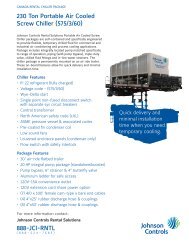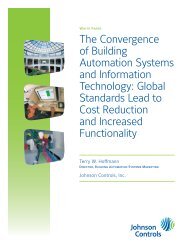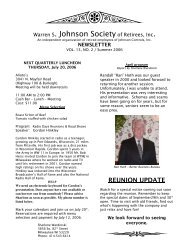Rxf - Johnson Controls Inc.
Rxf - Johnson Controls Inc.
Rxf - Johnson Controls Inc.
You also want an ePaper? Increase the reach of your titles
YUMPU automatically turns print PDFs into web optimized ePapers that Google loves.
Figure 33<br />
MOTOR BEARINGS<br />
Lubricate motor bearings properly<br />
before start-up. Maintain subsequent<br />
lubrication as recommended<br />
by the motor manufacturer. See Figure 33.<br />
OPERATING LOG<br />
The use of an operating log, as shown in this manual (see<br />
Table of Contents...FORMS), permits thorough analysis of<br />
the operation of a refrigeration system by those responsible<br />
for its maintenance and servicing. Continual recording of<br />
gauge pressures, temperatures, and other pertinent information<br />
enables the observer and serviceman to be constantly<br />
familiar with the operation of the system and to recognize<br />
immediately any deviations from normal operating conditions.<br />
It is recommended that readings be taken at least<br />
every four hours.<br />
TROUBLESHOOTING GUIDE<br />
Successful problem solving requires an organ ized ap proach to<br />
define the problem, identify the cause, and make the proper<br />
correction. Sometimes it is possible that two relatively obvious<br />
problems combine to provide a set of symptoms that<br />
can mislead the troubleshooter. Be aware of this possibility<br />
and avoid solving the “wrong problem”.<br />
ABNORMAL OPERATION<br />
ANALYSIS and CORRECTION<br />
Four logical steps are required to analyze an opera tional<br />
problem effectively and make the necessary correc tions:<br />
1. Define the problem and its limits.<br />
2. Identify all possible causes.<br />
3. Test each cause until the source of the problem is found.<br />
4. Make the necessary corrections.<br />
RXF ROTARY SCREW COMPRESSOR UNITS<br />
MAINTENANCE<br />
070.410-IOM (JUL 11)<br />
Page 31<br />
The first step in effective problem solving is to define the<br />
limits of the problem. If, for example, the compres sor periodically<br />
experienc es high oil tempera tures, do not rely on<br />
this observation alone to help identify the problem. On the<br />
basis of this information, the apparent corrective measure<br />
would appear to be a re adjustment of the liquid injection<br />
system. Lowering the equalizing pressure on the thermal<br />
expansion valve would in crease the refriger ant feed and the<br />
oil temperature should drop.<br />
If the high oil temperature was the result of high suction<br />
superheat, however, and not just a matter of improper liquid<br />
injection adjust ment, increasing the liquid feed could lead to<br />
other problems. Under low load conditions the liquid injection<br />
system may have a tendency to overfeed. The high suction<br />
superheat condition, moreov er, may only be tempor ary.<br />
When system conditions return to normal, the unit's liquid<br />
injection will overfeed and oil temperature will drop. In solving<br />
the wrong problem a new problem was creat ed.<br />
The following list of abnormal system condi tions can cause<br />
abnormal operation of the RXF compressor unit:<br />
1. Insufficient or excessive refrigeration load.<br />
2. Excessively high suction pressure.<br />
3. Excessively high suction superheat.<br />
4. Excessively high discharge pressure.<br />
5. Inadequate refrigerant charge or low receiv er level.<br />
6. Excessively high or low temperature coolant to the oil<br />
cooler.<br />
7. Liquid return from system (carryover).<br />
8. Refrigerant underfeed or overfeed to evapor ators.<br />
9. Blocked tubes or plates in water-cooled oil cooler from<br />
high mineral content of water.<br />
10. Insufficient evaporator or condenser siz ing.










![[PDF] Intelligent Fire Annunciator IFA-1000 - Johnson Controls Inc.](https://img.yumpu.com/7424420/1/190x245/pdf-intelligent-fire-annunciator-ifa-1000-johnson-controls-inc.jpg?quality=85)





